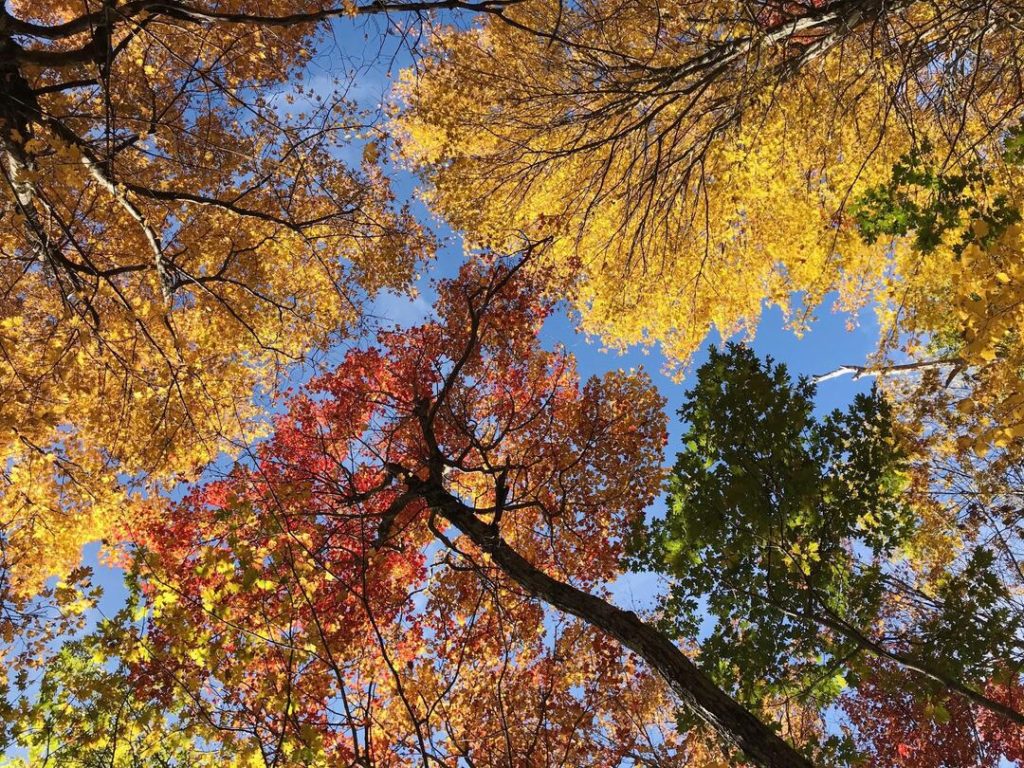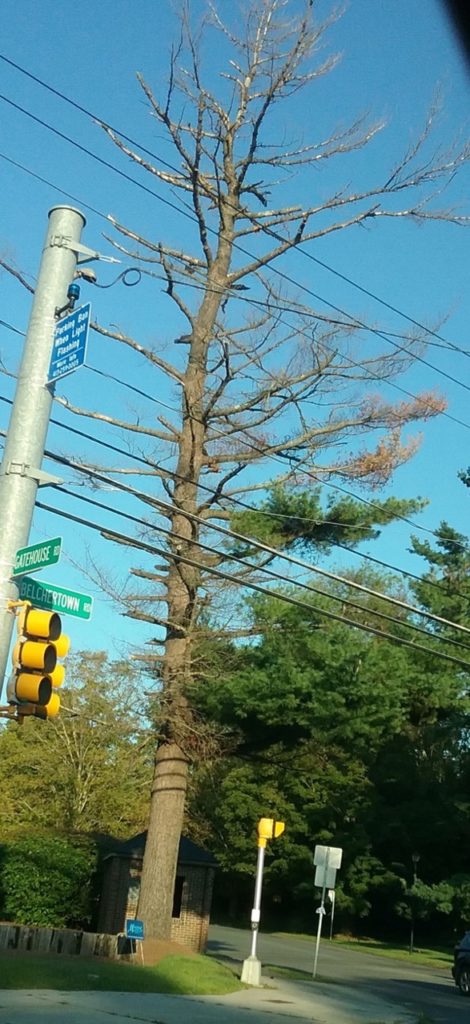A Few Questions For Alan Snow, The Guy In Charge Of Trees On Public Land In Amherst

Photo:Audubon Vermont. Creative Commons
Editor’s note: This interview with Alan Snow originally appeared in the Indy on August 30, 2019. This past week, tree crews have been out and about in Amherst, checking on the health of trees, clearing branches that extend too far over the roads, and taking down those trees that are dead or dying. With the intensifying decline of Sugar Maples in the Northeast (see also here), due at least in part to climate change, we thought it would be a good time to revisit Kitty Axelson-Berry’s interview with Amherst Tree Warden Alan Snow.
INDY: Can you say a little about your role here as the director of trees and grounds?
AS: I’ve been working for the town of Amherst as the division director of Trees and Grounds, in the Department of Public Works, for eight years. The Tree and Grounds division was formed in 2011 to combine the resources of the tree warden, the tree crew, and the parks department. The town’s tree warden had previously been a volunteer position, with the tree crew working under the Highway Division director, and the parks crew as its own program.
The Trees and Grounds division has nine full-time employees and operates seven days a week. We are responsible for the removal of trash from public trash containers around town, maintaining all of the town’s public trees, athletic fields, regional school fields, parks, commons, our two outdoor swimming pools, the indoor pool at the Middle School, three cemeteries (including the sale of plots, as well as burials), snow removal on over thirty miles of sidewalk, and a number of other responsibilities.
Putting the maintenance of over eighty acres of turf, and approximately 20,000 trees, under one division has allowed for cross-training of employees and shared use of specialized equipment. The tree crew side of the division consists of two staff who also do the majority of the cemetery work (with help from the parks side of the division when needed). Publicly I’m mostly known as the “tree warden” but the reality is that I spend an equal amount of time working on non-tree related issues or projects for the town.
I’ve lived in town for thirty years with my family and have been on several committees, including chair of the Public Shade Tree Committee, and acted as the volunteer tree warden for three years. I’ve been a Massachusetts Certified Arborist since the early 1990s and have a B.S. in Urban Forestry from UMass.
INDY: Eastern pine trees are apparently in decline here and there seem to be more dead or dying trees than in the past. What’s going on?

AS: Yes, well, there’s quite an uptick in tree declines including white pines, due to multiple issues. The white pines have been hit with several diseases/ fungi that began to impact our trees about five years ago. One of these fungi kills the second- and third-year pine needles, leaving the first year needles
untouched. Pines put on a new set of needles every year and drop their oldest set, so if a tree loses its third-year and second-year needles, and then the following year it loses what had been its first-year needles, then it hasn’t been able to store enough energy to put on another set of first-year needles, and the tree dies.
Once a white pine dies it will rapidly decline and start dropping twigs and branches, and will need removal if it’s in a heavy traffic area. I need to assess the likelihood of the tree failing and how likely, if part of the tree failed, would it be to cause damage or loss of life and property. With 106 miles of public roads in town, and roughly 20,000 trees, the biggest challenge is to identify and prioritize the truly high-risk trees and remove or prune them before they [die and] fail. We also receive daily requests for tree work…it is challenging to manage the expectations, with the level of service that’s possible with a two-person tree crew.
INDY: There are some dead pines in my neighborhood, Echo Hill South…
AS: Yes, Echo Hill area and Gatehouse Road is an excellent example of the impact the white pine decline is having. Just over the last four years we lost four large white pines on Gatehouse Road. These are difficult and costly trees to remove and they leave a big void in the landscape when they’re gone. There are dozens of pine trees around town, on public as well as private land, that are dying or dead and need to be removed before they fail.
INDY: What about other types of trees? So many trees look like they’re having problems.
AS: We’re seeing a rapid decline of sugar maples, the older population, and also sugar maples that are not so old. The term “decline complex” applies here. It indicates that there are multiple reasons for a decline. Weather events like drought, excessive heat or cold, or changes in precipitation cycles cause a cascading effect of disease and insect issues.
Older trees are often more susceptible than healthy young trees because they have more mass to maintain, and they aren’t growing as fast, whereas healthy young trees are growing faster and have less mass to maintain. Rapidly growing trees are better at warding off insects and diseases. But now I’m seeing a lot of young trees that should be thriving but are dying in a matter of years! East Pleasant Street near Strong Street is a good example, where many maple trees are dying. Parts of South East Street are also displaying this. It’s been challenging to keep up with the removals.
UMass Extension says that the drought followed by excessive soil moisture might be playing a role in this. The region has had a series of droughts during the last seven or so years, causing a lot of root deaths. And we’re also seeing a new moisture pattern—with drenching, soaking rains that saturate the soil, followed by very dry spells. There has been a lot of attention on this topic and how it impacts our trees.
With this pattern, well, the fungi love it! They’re native soil fungi that are always present in the soil but they seem to have become more prevalent in recent years.
Dutch elm disease (DED) is a problem that’s getting more virulent. In the past it burned through the area and so many elm trees…but there were some survivors. Now the survivors are succumbing to it, there’s been an uptick in DED killing mature American elms around the region. Even elm species that were bred to be resistant to Dutch elm disease are succumbing.
Emerald ash borer is probably in town because it has been found in surrounding communities—we just haven’t had an official sighting yet.
Wooly adelgid and elongated hemlock scale are still problems on hemlocks.
Though Amherst doesn’t have a large red pine population, the red pine scale is still a problem where you have a monoculture of red pine.
INDY: Are gypsy moths a problem this year?
AS: Over the past two years Amherst did have some defoliation and mortality from gypsy moth caterpillars, but we did see the population crash this spring before feeding reached critical mass. The funguses (and virus) that kill gypsy moths and help keep them in check disappeared for awhile because of dry conditions in the spring, so the gypsy moth population was able to grow. But it seems that the fungus kicked in this year, so we appear to have been spared from a significant defoliation event.
INDY: There are a lot of pale blue-grey-green funguses all over the trunks and, less so, the branches of trees this year. Are they harmful?
AS: You’re probably talking about lichens, not fungi, and no, they don’t do anything to the tree. They just live on it.
INDY: How can you keep up with analyzing so many trees? How big a crew do we have in Amherst to maintain healthy trees?
AS: We assess the health of a tree and the likelihood of the tree to fail in part or whole, any potential target and frequency of the target to be around the tree. Is it a park bench, a playground, a street like College Street, or a quiet dead-end street? I have to try to figure out which tree is the top priority, which trees can wait. We’re a two-person crew plus me, so we can’t get to everything we’d like to.
INDY: What else?
AS: I practice “community forestry.” I’m always trying to protect the tree canopy and leave space for trees in projects that are being undertaken. But most property here is privately owned. We need to educate property owners about the value of trees as lungs or air filters for our homes and community, literally sucking pollution out of the air, using it, and creating oxygen, as well as shading and cooling through transpiration. A single large shade tree intercepts thousands of gallons of stormwater. Trees hold water and prevent it from just running-off. If we don’t leave space for big trees and if we don’t nurture trees, they won’t be able to clean the air, hold down the soil, cool our air, block wind and cold…we’ll need more air conditioners and heating, and more stormwater infrastructure.
You might want to check out https://www.itreetools.org, which has a suite of online tools to calculate the contribution of specific trees on your own property, how they contribute to the environment. The Shade Tree Committee put up a few signs last year on individual trees, telling how many tons of carbon the tree sequesters, how much run-off it prevents…and they’re working to post more of them soon.
INDY: Did I hear you right—a single large tree intercepts thousands of gallons of storm water?
AS: Yes, you did. Per year!

1 thought on “A Few Questions For Alan Snow, The Guy In Charge Of Trees On Public Land In Amherst”